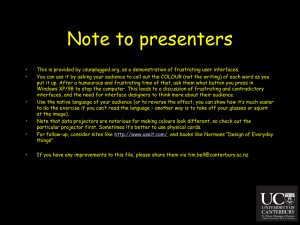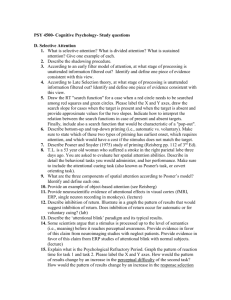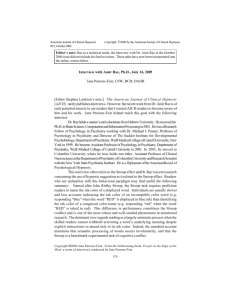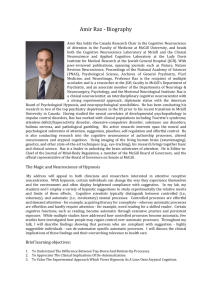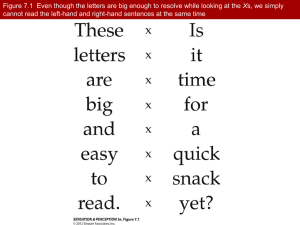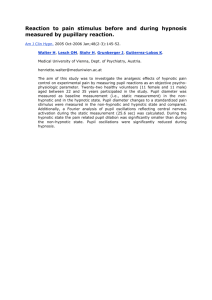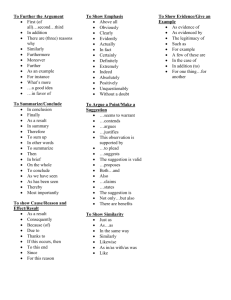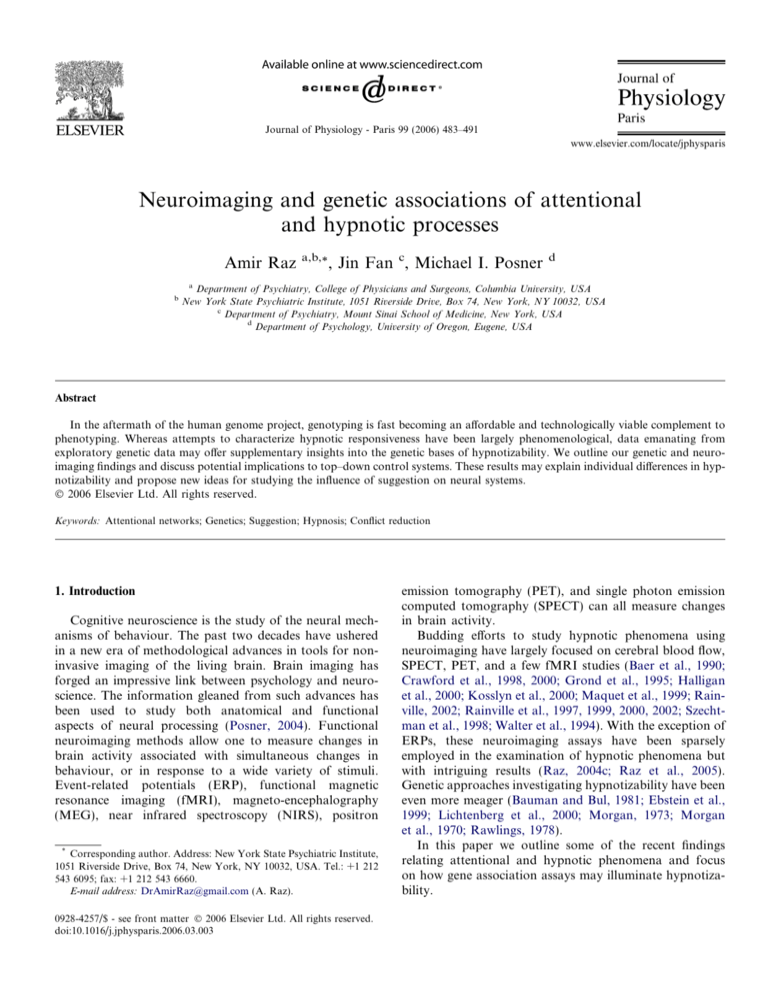
Journal of Physiology - Paris 99 (2006) 483–491
www.elsevier.com/locate/jphysparis
Neuroimaging and genetic associations of attentional
and hypnotic processes
Amir Raz
b
a,b,*
, Jin Fan c, Michael I. Posner
d
a
Department of Psychiatry, College of Physicians and Surgeons, Columbia University, USA
New York State Psychiatric Institute, 1051 Riverside Drive, Box 74, New York, NY 10032, USA
c
Department of Psychiatry, Mount Sinai School of Medicine, New York, USA
d
Department of Psychology, University of Oregon, Eugene, USA
Abstract
In the aftermath of the human genome project, genotyping is fast becoming an affordable and technologically viable complement to
phenotyping. Whereas attempts to characterize hypnotic responsiveness have been largely phenomenological, data emanating from
exploratory genetic data may offer supplementary insights into the genetic bases of hypnotizability. We outline our genetic and neuroimaging findings and discuss potential implications to top–down control systems. These results may explain individual differences in hypnotizability and propose new ideas for studying the influence of suggestion on neural systems.
Ó 2006 Elsevier Ltd. All rights reserved.
Keywords: Attentional networks; Genetics; Suggestion; Hypnosis; Conflict reduction
1. Introduction
Cognitive neuroscience is the study of the neural mechanisms of behaviour. The past two decades have ushered
in a new era of methodological advances in tools for noninvasive imaging of the living brain. Brain imaging has
forged an impressive link between psychology and neuroscience. The information gleaned from such advances has
been used to study both anatomical and functional
aspects of neural processing (Posner, 2004). Functional
neuroimaging methods allow one to measure changes in
brain activity associated with simultaneous changes in
behaviour, or in response to a wide variety of stimuli.
Event-related potentials (ERP), functional magnetic
resonance imaging (fMRI), magneto-encephalography
(MEG), near infrared spectroscopy (NIRS), positron
*
Corresponding author. Address: New York State Psychiatric Institute,
1051 Riverside Drive, Box 74, New York, NY 10032, USA. Tel.: +1 212
543 6095; fax: +1 212 543 6660.
E-mail address: DrAmirRaz@gmail.com (A. Raz).
0928-4257/$ - see front matter Ó 2006 Elsevier Ltd. All rights reserved.
doi:10.1016/j.jphysparis.2006.03.003
emission tomography (PET), and single photon emission
computed tomography (SPECT) can all measure changes
in brain activity.
Budding efforts to study hypnotic phenomena using
neuroimaging have largely focused on cerebral blood flow,
SPECT, PET, and a few fMRI studies (Baer et al., 1990;
Crawford et al., 1998, 2000; Grond et al., 1995; Halligan
et al., 2000; Kosslyn et al., 2000; Maquet et al., 1999; Rainville, 2002; Rainville et al., 1997, 1999, 2000, 2002; Szechtman et al., 1998; Walter et al., 1994). With the exception of
ERPs, these neuroimaging assays have been sparsely
employed in the examination of hypnotic phenomena but
with intriguing results (Raz, 2004c; Raz et al., 2005).
Genetic approaches investigating hypnotizability have been
even more meager (Bauman and Bul, 1981; Ebstein et al.,
1999; Lichtenberg et al., 2000; Morgan, 1973; Morgan
et al., 1970; Rawlings, 1978).
In this paper we outline some of the recent findings
relating attentional and hypnotic phenomena and focus
on how gene association assays may illuminate hypnotizability.
484
A. Raz et al. / Journal of Physiology - Paris 99 (2006) 483–491
2. Attention
Because attention has a distinct anatomy that carries out
basic psychological functions and that can be influenced by
specific brain injuries and states, some researchers promoted the notion of attention as an organ system (Posner
and Fan, in press). Attention selects aspects of the environment (e.g., objects) or ideas stored in our memory for conscious processing at any given time. Investigators have
been studying attentional operations for about a century.
William James argued that attending is the same as being
aware, but unlike what he thought we now know that certain aspects of attention can be involuntary and can occur
unconsciously. Since the 1980s human neuroimaging studies have allowed examination of the whole brain during
tasks involving attention and consequently provided us
with much information on how the brain houses these
attentional processes (Posner and Fan, in press; Posner
and Petersen, 1990). The ability to trace anatomical
changes over time has provided methods for validating
and improving pharmacological and other forms of
therapy.
3. Attentional networks
Attention can be viewed as a system of anatomical areas
carrying out the functions of alerting, orienting, and executive control (Raz and Buhle, 2006). In line with an attentional research agenda (Raz, 2004b,c; Raz and Buhle, 2006;
Raz and Shapiro, 2002), we have recently devised a simple
attention network test (ANT) that can be performed by
adults, children, patients and even non-human animals
(Fan et al., 2002). The ANT takes about half an hour to
administer and provides three numbers that indicate the
efficiency of the networks that perform the alert, orient
and conflict resolution functions, respectively. Our previous work with this test has provided evidence on its
reliability, its heritability, and the independence of the
results for the three different attentional functions (Fan
et al., 2001a,b; Fossella et al., 2002a,b).
Although previous studies have examined the areas
involved in the components of the ANT (Corbetta et al.,
2000; Hopfinger et al., 2000), recent research reported data
concerning the brain areas involved in carrying out the
ANT as a whole—first as a preliminary report (Fan
et al., 2001a) and later more formally (Fan et al., 2005;
Raz, 2004a). These fMRI findings suggest that this test
activates three largely orthogonal networks related to components of attention (see Fig. 1). Pharmacological studies
(e.g., Marrocco and Davidson, 1998) have related each of
the networks with specific chemical neuromodulators: cholinergic systems arising in the basal forebrain play an
important role in orienting; the norepinephrine (NE) system arising in the locus coeruleus of the midbrain is
involved in alerting; and the anterior cingulate cortex
(ACC) and lateral prefrontal cortex are target areas of
the mesocortical dopamine system—involved in executive
attention. fMRI activations (Fig. 1) of the cross-sectional
view of the alerting network shows thalamic activation
(i.e., alerting effect). The cross-sectional view of the
orienting network shows parietal activation. And the
cross-sectional view of the conflict network shows ACC
activation.
4. Attentional and hypnotic phenomena
Hypnosis is often labeled as attentive receptive concentration (Spiegel and Spiegel, 1987). Indeed, evidence relating hypnotic phenomena to attentional mechanisms is
mounting (Raz et al., 2002b) and there is general accord
that hypnotic phenomena implicate attention (Karlin,
1979) and relate to self-regulation (Posner and Rothbart,
1998). Whereas a number of investigators have hypothesized that suggestibility correlates with underlying differences in individual patterns of waking attention (Tellegen
and Atkinson, 1974), theories of hypnotic responding differ
regarding attentional processes (Kirsch et al., 1999).
The marriage of attention and hypnosis led to a research
agenda using hypnosis to examine disparate attentional
networks (Raz and Shapiro, 2002). Drawing on behavioural (Raz et al., 2002b), optical (Raz et al., 2003), and
neuroimaging assays (Raz et al., 2002a,b,d), we recently
reported both the elimination and removal of Stroop interference under a specific posthypnotic suggestion to obviate
reading in highly hypnotizable subjects (Raz et al., 2002b,
2003, 2005, 2006). These results are in line with published
as well as unpublished case studies (MacLeod and Sheehan, 2003; Schatzman, 1980; Wheatley, 2003). However,
replication of the wholesale group effect has been intangible for some researchers and further research needs to
elucidate whether these differences are due to random variations or other methodological discrepancies.
In the classic Stroop task experienced readers are asked
to name the ink color of a displayed word (Stroop, 1935).
Responding to the ink color of an incompatible color word
(e.g., the word ‘‘RED’’ displayed in blue ink), subjects are
usually slower and less accurate than identifying the ink
color of a control item (e.g., ‘‘***’’ or ‘‘LOT’’ inked in
red). This difference in performance is called the Stroop
interference effect (SIE) and is one of the most robust
and well-studied phenomena in attentional research
(MacLeod, 1992; MacLeod and MacDonald, 2000).
Although there is gradual appreciation that word reading
can be mediated by attention, it is still largely considered
automatic because a proficient reader cannot withhold
accessing the words’ meaning despite explicit instructions
to attend only to the ink color. Indeed, the standard
account in both the word recognition and Stroop literatures maintains that words are automatically processed to
the semantic level (MacLeod, 1991; Neely, 1991) and that
the SIE is therefore the ‘‘gold standard’’ to study attentional measures (MacLeod, 1992). Nonetheless, our results
(i.e., that effective posthypnotic suggestion consistently
cancelled the SIE in highly hypnotizable individuals) indi-
A. Raz et al. / Journal of Physiology - Paris 99 (2006) 483–491
485
Fig. 1. Anatomy of attentional networks. fMRI images collected from sixteen healthy adults performing the ANT in a 3T GE magnet. Cross-sectional
views of (1) the alerting network show thalamic activation (i.e., alerting effect), (2) the orienting network show parietal activation, and (3) the conflict
network show ACC activation. First reported in a poster by Fan et al. (2001a), this figure outlines some of the functional anatomy subserving the distinct
attentional networks. The pulvinar, superior colliculus, superior parietal lobe and frontal eye fields are often found active in studies of the orienting
network; the anterior cingulate gyrus is an important part of the executive network (i.e., selective attention and conflict resolution), and the right frontal
and parietal areas are active when people maintain the alert state (See also Fan and Posner, 2004; Fan et al., 2003b, 2005; Raz, 2004a; Raz and Buhle,
2006; Raz and Shapiro, 2002).
cate that the effect must operate via a top–down cognitive
mechanism that modifies the processing of input words.
Since the SIE typically activates the dorsal part of the
ACC, these data support the view that monitoring conflict
among potential responses involves the dorsal ACC
(Botvinick et al., 2001).
Neuroimaging studies of executive attention have been
conducted using either Stroop or Stroop-like tasks (Bush
et al., 2000). Another frequently used conflict task requires
a response to a central stimulus (e.g., an arrow pointing
left) when it is surrounding by flankers that either point
in the same direction (congruent) or in the opposite direction (incongruent). These conflict tasks have been shown
by neuroimaging studies to activate midline frontal areas
(e.g., ACC), and lateral prefrontal cortex. Thus, these
experimental tasks provide a way to tease out the functional contributions of areas within the executive attention
network. The preponderance of the evidence indicates that
lateral prefrontal areas are involved in representing specific
information over time (working memory), while medial
ACC areas are related to the detection of conflict.
5. Using posthypnotic suggestion to reduce conflict in the
human brain
Some researchers have attempted to explore the Stroop
effect under hypnosis (Blum and Graef, 1971; Blum and
Wiess, 1986; Dixon et al., 1990a; Dixon and Laurence,
486
A. Raz et al. / Journal of Physiology - Paris 99 (2006) 483–491
1992; MacLeod and Sheehan, 2003; Nordby et al., 1999;
Sheehan et al., 1988; Spiegel et al., 1985; Sun, 1994; Szechtman et al., 1998). However, these assays have largely concentrated on the effect of hypnosis without suggestion and
often used non-classical Stroop paradigms (Sheehan et al.,
1988). Historical single-case reports (MacLeod and Sheehan, 2003; Schatzman, 1980), esoteric publications (Sun,
1994), and informal personal communications (Wheatley,
2003) proposing hypnotic removal of Stroop conflict have
not been rigorously pursued prior to our research efforts.
Multiple neuroimaging studies using variations of conventional Stroop tasks have activated a network of brain
areas including the dorsal ACC. Requiring participants
to respond to one dimension of a stimulus rather than a
strong conflicting dimension (Botvinick et al., 2001; Bush
et al., 2000; MacDonald et al., 2000), these data have
resulted in a popular theory of cognitive control proposing
that the ACC is part of a network involved in handling
conflict between neural areas (Botvinick et al., 2001; Bush
et al., 2000). While some researchers view the ACC through
the lens of a conflict monitoring model (Botvinick et al.,
2001; Cohen et al., 2000), others construe it as a regulation
model engulfing broader processes of consciousness and
self-regulation including executive attention and mentation
(Bush et al., 2000).
To unravel the brain mechanism by which the posthypnotic suggestion curtailed Stroop conflict (i.e., how
suggestion affected visual processing), we studied highly
hypnotizable (HH) and less hypnotizable (LH) participants
both with and without a suggestion not to see the input as
words. We complemented the superior spatial resolution of
fMRI by event-related scalp electrical potentials (ERPs)—
affording high temporal resolution—which were acquired
separately while the same participants performed similar
Stroop tasks. Data from this combined event-related fMRI
and ERPs study recently illuminated the mechanism by
which the posthypnotic suggestion to view Stroop words
as foreign signs operated in HH subjects. The results show
that the elimination of the Stroop conflict resulted in an
attenuation of fMRI signal at the ACC and extrastriate
areas (Raz et al., 2002a,b,d). Reports of these findings
recently appeared in a number of accounts (Raz, 2004c;
Raz and Buhle, 2006; Raz et al., 2005).
These data are consistent with reports that both attention and suggestion can modulate neural activity for visual
stimuli (Kosslyn et al., 2000; Mack, 2002; Martinez et al.,
1999; Rees et al., 1999). For example, by creating a situation in which subjects could look directly at a five-letter
word without attending to it (i.e., they had to respond to
a superimposed stream of pictures shown in different orientations), an fMRI study reported failure to perceive words
even for decidedly familiar and meaningful stimuli placed
at the center of gaze (Rees et al., 1999). Additionally, positron emission tomography (PET) data showed that HH
individuals neither perceived color nor activated extrastriate areas related to color after they had been instructed
to see a color pattern in gray-scale (Kosslyn et al., 2000).
Finally, PET assays of pain showed that specific modulatory hypnotic suggestions could affect activation of different brain structures: whereas suggesting a drop in pain
unpleasantness (i.e., pacifying conflict) reduced specific
activity in ACC (Rainville et al., 1997), suggesting
decreased pain intensity produced activity reduction in
somatosensory cortex (Hofbauer et al., 2001). These
accounts underline the influence attention and suggestion
can impart to conflict situations and top–down cognitive
control (Posner and Rothbart, 1998; Rainville, 2002;
Rainville et al., 2002; Raz and Shapiro, 2002).
The higher temporal resolution afforded by scalp ERPs,
whose source was localized more anteriorly, illustrated
early reduction of brain waves under the experimental suggestion. Comparing the effects of suggestion (absent versus
present) for the incongruent trials in the HH group, electrophysiological activity differed as early as 100 ms following word presentation (see Fig. 2). These data revealed that
in contrast to no suggestion, the N1—an early ERP component thought to be related to directing attention to an
information channel—was absent under suggestion, and
posterior activity was not observed before 250 ms. These
findings strongly propose that the absence of conflict was
accomplished by changing the way visual input was processed. To relate the fMRI with the ERP data, brain electrical source analyses (BESA) explored the time course of
the fMRI generators and provided evidence consistent with
independent generators at both the ACC and cuneus.
In addition to data speaking to the reduced conflict resolution effect, using posthypnotic suggestion, the experimental design demonstrated how it is practically possible
to dissociate attention based upon input processing from
sensory activity based upon the input stream. While this
outcome seems to leave as a puzzle how visual input got
reduced by the posthypnotic suggestion—one possibility
is that all input was reduced; another is that it was word
specific—the ERP data tend to support the former. Furthermore, recent ERP data examining the error-related
negativity (ERN), an electrophysiological index closely
associated with commission of errors in cognitive tasks
involving response conflict (Carter et al., 1998; Falkenstein
et al., 1991; Gehring and Fencsik, 2001), showed that while
the posthypnotic suggestion reduced conflict, it did not
decrease conflict monitoring (Raz et al., 2005). Compared
to the no posthypnotic suggestion condition, ACC activation decreased prior to response under suggestion, but then
ACC activation increased upon incorrect responses on
incongruent trials regardless of suggestion. Thus, it was
possible to eliminate conflict resolution (i.e., early ACC
diminution) yet maintain conflict monitoring (i.e., ACC
activation following incorrect responses).
Finally, recent behavioural data collected from comparing hypnotic and non-hypnotic suggestions using a similar
experimental protocol at the University of Connecticut
also showed significant reduction, but not elimination, of
Stroop conflict under both hypnotic and non-hypnotic suggestions (Pollard et al., 2003). Interpretation of these data
A. Raz et al. / Journal of Physiology - Paris 99 (2006) 483–491
487
Fig. 2. Table A shows regions of significant fMRI activations on Stroop conflict comparing posthypnotic suggestion with no suggestion in highly
suggestible individuals. The Talairach coordinates (x, y, z) for the maximally activated voxel in each of the regions and their Z-value are shown. To relate
the fMRI with the ERP data, brain electrical source analyses (BESA) explored the time course of the fMRI generators. Figure B shows the six fixed dipoles
placed at locations suggested by the fMRI data from Table 2A. The BESA algorithm provided evidence consistent with independent generators at both the
anterior cingulate cortex and cuneus. Figure C shows representative ERP snapshots between 100 ms and 250 ms. These snapshots are taken from a video
animation based on two-dimensional maps of scalp voltages, which were constructed by spherical spline interpolation mapping across twelve highly
suggestible individuals on incongruent Stroop trials answered correctly as a function of suggestion. Within each pair, the right and left images indicate
electrical activity with and without suggestion, respectively. Differences in activation patterns are seen 100–250 ms following word presentation. These data
provide decisive evidence that, compared to the suggestion-absent condition, brain activity in posterior and anterior regions was largely removed following
the experimental suggestion. These data support the notion that suggestion affected processing of the entire visual stream and was not specific to visual
words.
proposed that susceptibility to suggestion, not explicit hypnotic procedures, may have been the critical factor under-
lying Stroop conflict reduction (Braffman and Kirsch,
1999; Kirsch and Braffman, 2001; Pollard et al., 2003).
488
A. Raz et al. / Journal of Physiology - Paris 99 (2006) 483–491
6. Genetics of hypnotizability
Despite some general results, the genetic bases of hypnotizability remain largely unclear. The bulk of the evidence
in the field dates 20–30 years ago and centers on twin data
reported by Morgan et al. (Morgan, 1973; Morgan et al.,
1970). Whereas the former study reports a correlation of
0.63 for monozygotic (MZ) twins and 0.08 for dizygotic
(DZ) twins, the latter study reported 0.52 for MZ twins
and 0.18 for DZ twins. Rawlings (1978) and Bauman and
Bul (1981) echoed similar findings in subsequent reports.
These data were not pursued further until the recent revolution in the field of genetics.
For more than a decade, the Human Genome Project
has made great progress in the identification of the protean
30 000 genes in the human genome as well as the approximately 1.7 million polymorphic sites scattered across the
six billion base-pair length of the human genome (Wolfsberg et al., 2002). These findings illuminate how genes
influence disease development, aid scientists looking for
genes associated with particular diseases, contribute to
the discovery of new treatments, and afford insights into
behavioural genetics (i.e., the relationship among certain
genetic configurations and manifest behaviour).
Pioneering recent efforts to establish viable relations
between phenotype and genotype, Richard Ebstein’s group
from Israel examined a number of such correlations,
including an association between catechol–Omethioninehyltransferase (COMT) high/low enzyme activity polymorphism and hypnotizability (Ebstein et al., 1999;
Lichtenberg et al., 2000). Their data, using the Stanford
hypnotic susceptibility scale form C (SHSS-C) administered in both Hebrew and English, revealed a significant
difference in hypnotizability between subjects who carried
the valine/methionine and valine/valine COMT genotypes.
Our fMRI data identified signal changes in neuroanatomical loci rich in dopaminergic innervation (e.g., ACC)
(Raz et al., 2002d) and reduction of conflict as a result of
posthypnotic suggestion (Raz, 2004c). Drugs known to
affect the dopaminergic system as well as alter consciousness (e.g., propofol) seem to induce hypnosis-like experiences and modulate executive attention (DiFlorio, 1993;
Fiset et al., 1999; Rainville et al., 2002; Xie et al., 2004).
COMT is a gene that influences performance on prefrontal
executive cognition and working memory tasks (Weinberger et al., 2001). Accordingly, we wanted to re-examine
the results reported by Lichtenberg et al. (2000).
We compared variations in hypnotic susceptibility
among healthy volunteers with differences in multiple
dopaminergic genes from contributed DNA. We screened
80 subjects using the SHSS-C without the Anosmia to
Ammonia item (Raz et al., 2002c). Each subject provided
a small sample of DNA (via a sterile cheek swab), which
was genotyped for a few well-known genetic polymorphisms in dopaminergic genes including DRD3, DRD4,
MAOA, DAT, and COMT as previously described
(Fossella et al., 2002).
Fig. 3. COMT and hypnotizability. Distributions of COMT genotypes vs.
SSHS-C hypnotizability score. The Y-axis shows hypnotizability scores
(mean ± Standard error). The X-axis shows the distribution for each
genotypic class at the COMT valine108/158 methionine polymorphism.
In line with data by Lichtenberg et al. (2000), we found a
polymorphism in the COMT gene to be related to hypnotizability (see Fig. 3). Specifically, valine/methionine heterozygous subjects were more highly suggestible than either
valine/valine or methionine/methionine homozygous subjects. The inverted U-shaped trend of valine/methionine
COMT heterozygotes towards higher hypnotizability is
congruent with data collected by other researchers (e.g.,
Lichtenberg et al., 2000) but differs from our previous studies examining the role of COMT in executive attention as
measured by the ANT as well as by the Stroop (Sommer
et al., 2004). Studies on the ANT found that subjects with
the valine/valine genotype showed somewhat more efficient
conflict resolution (lower SIE) than subjects with the valine/
methionine genotype (Fossella et al., 2002). This trend was
also seen in subjects who performed the Stroop task
(Sommer et al., 2004). The valine allele of COMT, which
confers relatively higher levels of enzyme activity and thus
lower relative amounts of extrasynaptic dopamine, has been
examined in the context of neuroimaging studies where it
correlated with lower activity of the dorsolateral prefrontal
cortex (Egan et al., 2001). Results from other genetic polymorphisms including DRD3, DRD4, MAOA and DAT
showed no significant associations with hypnotizability.
7. Individual differences in attention and hypnotizability
Normal individuals differ in the efficiency of each of the
attentional networks. For example, this can be examined
by evaluating alerting, orienting and executive attention
using the ANT. Self-report scales have also been used to
study individual differences in attentional components.
One higher-level factor called effortful control involves the
ability to voluntarily shift and focus attention and inhibit
certain information. Effortful control as reported by the
subject seems to relate most closely to the executive atten-
A. Raz et al. / Journal of Physiology - Paris 99 (2006) 483–491
tion network. Similar to the hypnosis data, here too twin
studies have suggested that the difference between people
in effortful control is highly heritable. Furthermore, individuals high in effortful control also report themselves as
relatively low in negative emotion. This is one source of
evidence supporting the idea that executive attention is
important for control of both cognition and emotion.
Using modified Stroop procedures, some researchers
have examined highly versus less hypnotizable subjects outside of hypnosis (Dixon et al., 1990b; Dixon and Laurence,
1992). Reliable differences were found between the groups.
Stroop interference was significantly larger for the highly
hypnotizables compared to the less hypnotizables (Raz
et al., 2002b). This finding was taken to suggest that outside of the hypnotic context highly hypnotizables processed
words more automatically than less hypnotizables. However, it also implies that the baseline efficiency of the executive attention network of highly hypnotizables deviates
significantly from the baseline level of their less hypnotizable colleagues. In this regard, our nascent COMT findings
may herald a genetic approach to hypnotizability whereby
a genotype may suggest a ‘‘biological propensity’’ to complement an attentional phenotype (e.g., hypnotizability).
8. Conclusion
We outline close links between attentional and hypnotic
mechanisms and provide some preliminary data to support
a candidate gene approach to attention and hypnotizability.
We have shown that neuroimaging assays and exploratory
genetic associations from the domain of attentional
research may illuminate hypnotic phenomena. Hypnosis is
a complex phenomenon likely to be associated with many
genetic polymorphisms. While COMT is not to be confused
with the ‘‘hypnotizability gene’’, as data accumulate from
multiple laboratories, meta-analyses of the various findings
will likely increase our appreciation of genotyping as an
important supplement to phenotyping (Fan et al., 2003a).
Since hypnosis can significantly alter performance for
highly suggestible persons on attentional tasks such as the
Stroop and ANT, our collective results support a potential
common mechanism of dopaminergic modulation affecting
both performance on attentional tasks and hypnotizability.
Such a common mechanism may, however, overlap with
different aspects of executive attention as suggested by an
analysis of within-subject correlations of interference on
the ANT and Stroop tasks (Sommer et al., in press). This
approach may underline significant disparity between the
cognitive capacities of highly and less-suggestible individuals and is likely to impact future research.
References
Baer, L., Ackerman, R., Surman, O., Correia, J., Griffith, J., Alpert,
N.M., Hackett, T., 1990. PET studies during hypnosis and hypnotic
suggestion. In: Berner, P. (Ed.), Psychiatry: The State of the Art,
489
Biological Psychiatry, Higher Nervous Activity, vol. 2. Plenum Press,
New York, NY, pp. 293–298.
Bauman, D.E., Bul, P.I., 1981. Human inheritability of hypnotizability.
Genetika 17, 352–356.
Blum, G.S., Graef, J.R., 1971. The detection over time of subjects
simulating hypnosis. Int. J. Clin. Exp. Hypn. 19, 211–224.
Blum, G.S., Wiess, F., 1986. Attenuation of symbol/word interference by
posthypnotic negative hallucination and agnosia. Exp. Klinische Hyp.
2, 58–62.
Botvinick, M.M., Braver, T.S., Barch, D.M., Carter, C.S., Cohen, J.D.,
2001. Conflict monitoring and cognitive control. Psychol. Rev. 108,
624–652.
Braffman, W., Kirsch, I., 1999. Imaginative suggestibility and hypnotizability: an empirical analysis. J. Pers. Soc. Psychol. 77, 578–587.
Bush, G., Luu, P., Posner, M.I., 2000. Cognitive and emotional influences
in anterior cingulate cortex. Trends Cogn. Sci. 4, 215–222.
Carter, C.S., Braver, T.S., Barch, D.M., Botvinick, M.M., Noll, D.,
Cohen, J.D., 1998. Anterior cingulate cortex, error detection, and the
online monitoring of performance. Science 280, 747–749.
Cohen, J.D., Botvinick, M., Carter, C.S., 2000. Anterior cingulate and
prefrontal cortex: who’s in control? Nat. Neurosci. 3, 421–423.
Corbetta, M., Kincade, J.M., Ollinger, J.M., McAvoy, M.P., Shulman,
G.L., 2000. Voluntary orienting is dissociated from target detection in
human posterior parietal cortex. Nat. Neurosci. 3, 292–297.
Crawford, H.J., Horton, J.E., Harrington, G.C., Vendemia, J.M.C., Plantec,
M.B., Jung, S., Shamrow, C., Downs, J.H., 1998. Hypnotic analgesia
(disattending pain) impacts neural network activation: an fMRI study of
noxious somatosensory TENS stimuli. Neuroimage 7, 436.
Crawford, H.J., Horton, J.E., Harrington, G.S., Hirsch, D.T., Fox, K.,
Daugherty, S., Downs, J.H., 2000. Attention and disattention (hypnotic analgesia) to noxious somatosensory TENS stimuli: fMRI
differences in low and highly hypnotizable individuals. Paper presented
at the Sixth Annual Meeting of the Organization for Human Brain
Mapping, June 15, San Antonio, TX.
DiFlorio, T., 1993. Is propofol a dopamine antagonist? Anesth. Analg. 77,
200–201.
Dixon, M., Laurence, J.R., 1992. Hypnotic susceptibility and verbal
automaticity: automatic and strategic processing differences in the
Stroop color-naming task. J. Abnorm. Psychol. 101, 344–347.
Dixon, M., Brunet, A., Laurence, J.R., 1990a. Hypnotic susceptibility and
verbal automatic and strategic processing differences in the Stroop
color-naming task. J. Abnorm. Psychol. 99, 336–343.
Dixon, M., Brunet, A., Laurence, J.R., 1990b. Hypnotizability and
automaticity: toward a parallel distributed processing model of
hypnotic responding. J. Abnorm. Psychol. 99, 336–343.
Ebstein, R.P., Bachner-Melman, R., Lichtenberg, P., 1999. Genetic and
cognitive factors in hypnotizability: Association between the low
enzyme activity catechol O-methyl transferase (COMT) MET allele
and high hypnotizability. Mol. Psychiat. 4 (Suppl), 1–2.
Egan, M.F., Goldberg, T.E., Kolachana, B.S., Callicott, J.H., Mazzanti,
C.M., Straub, R.E., Goldman, D., Weinberger, D.R., 2001. Effect of
COMT Val108/158 Met genotype on frontal lobe function and risk for
schizophrenia. Proc. Natl. Acad. Sci. USA 98, 6917–6922.
Falkenstein, M., Hohnsbein, J., Hoormann, J., Blanke, L., 1991. Effects of
crossmodal divided attention on late ERP components. II. Error
processing in choice reaction tasks. Electroencephalogr. Clin. Neurophysiol. 78, 447–455.
Fan, J., McCandliss, B.D., Flombaum, J.I., Posner, M.I., 2001a. Imaging
attentional networks. Paper presented at the Annual Meeting of the
Society for Neuroscience, San Diego, CA.
Fan, J., Wu, Y., Fossella, J.A., Posner, M.I., 2001b. Assessing the
heritability of attentional networks. BMC Neurosci. 2, 14.
Fan, J., McCandliss, B.D., Sommer, T., Raz, A., Posner, M.I., 2002.
Testing the efficiency and independence of attentional networks. J.
Cogn. Neurosci. 14, 340–347.
Fan, J., Fossella, J., Sommer, T., Wu, Y., Posner, M.I., 2003a. Mapping
the genetic variation of executive attention onto brain activity. Proc.
Natl. Acad. Sci. USA 100, 7406–7411.
490
A. Raz et al. / Journal of Physiology - Paris 99 (2006) 483–491
Fan, J., Raz, A., Posner, M.I., 2003b. Attentional mechanisms. In:
Aminoff, M.J., Daroff, R.B. (Eds.), Encyclopedia of Neurological
Sciences, Vol. 1. Elsevier Science, New York, pp. 292–299.
Fan, J., Posner, M., 2004. Human attentional networks. Psychiatr. Prax.
31 (Suppl. 2), S210–S214.
Fan, J., McCandliss, B.D., Fossella, J., Flombaum, J.I., Posner, M.I.,
2005. The activation of attentional networks. Neuroimage 26 (2), 471–
479.
Fiset, P., Paus, T., Daloze, T., Plourde, G., Meuret, P., Bonhomme, V.,
Hajj-Ali, N., Backman, S.B., Evans, A.C., 1999. Brain mechanisms of
propofolinduced loss of consciousness in humans: a positron emission
tomographic study. J. Neurosci. 19, 5506–5513.
Fossella, J., Posner, M.I., Fan, J., Swanson, J.M., Pfaff, D.W., 2002a.
Attentional phenotypes for the analysis of higher mental function. The
Scientific World 2, 217–223.
Fossella, J.A., Sommer, T., Fan, J., Wu, Y., Swanson, J.M., Pfaff, D.W.,
Posner, M.I., 2002b. Assessing the molecular genetics of attention
networks. BMC Neurosci. 3, 14.
Gehring, W.J., Fencsik, D.E., 2001. Functions of the medial frontal cortex
in the processing of conflict and errors. J. Neurosci. 21, 9430–9437.
Grond, M., Pawlik, G., Walter, H., Lesch, O.M., Heiss, W.D., 1995.
Hypnotic catalepsy-induced changes of regional cerebral glucose
metabolism. Psychiat. Res. 61, 173–179.
Halligan, P.W., Athwal, B.S., Oakley, D.A., Frackowiak, R.S., 2000.
Imaging hypnotic paralysis: implications for conversion hysteria.
Lancet 355, 986–987.
Hofbauer, R.K., Rainville, P., Duncan, G.H., Bushnell, M.C., 2001.
Cortical representation of the sensory dimension of pain. J. Neurophysiol. 86, 402–411.
Hopfinger, J.B., Buonocore, M.H., Mangun, G.R., 2000. The neural
mechanisms of top–down attentional control. Nat. Neurosci. 3, 284–
291.
Karlin, R.A., 1979. Hypnotizability and attention. J. Abnorm. Psychol.
88, 92–95.
Kirsch, I., Braffman, W., 2001. Imaginative suggestibility and hypnotizability. Curr. Dir. Psychol. Sci. 10, 57–61.
Kirsch, I., Burgess, C.A., Braffman, W., 1999. Attentional resources in
hypnotic responding. Int. J. Clin. Exp. Hypn. 47, 175–191.
Kosslyn, S.M., Thompson, W.L., Costantini-Ferrando, M.F., Alpert,
N.M., Spiegel, D., 2000. Hypnotic visual illusion alters color processing in the brain. Am. J. Psychiat. 157, 1279–1284.
Lichtenberg, P., Bachner-Melman, R., Gritsenko, I., Ebstein, R.P., 2000.
Exploratory association study between catechol-O-methyltransferase
(COMT) high/low enzyme activity polymorphism and hypnotizability.
Am. J. Med. Genet. 96, 771–774.
MacDonald, A.W., Cohen, J.D., Stenger, V.A., Carter, C.S., 2000.
Dissociating the role of the dorsolateral prefrontal and anterior
cingulate cortex in cognitive control. Science 288, 1835–1838.
Mack, A., 2002. Is the visual world a grand illusion? A response. J.
Conscious. Stud. 9, 102–110.
MacLeod, C.M., 1991. Half a century of research on the Stroop effect: an
integrative review. Psychol. Bull. 109, 163–203.
MacLeod, C.M., 1992. The Stroop task: The ‘‘gold standard’’ of
attentional measures. J. Exp. Psychol. Gen. 121, 12–14.
MacLeod, C.M., MacDonald, P.A., 2000. Interdimensional interference in
the Stroop effect: uncovering the cognitive and neural anatomy of
attention. Trends Cogn. Sci. 4, 383–391.
MacLeod, C.M., Sheehan, P.W., 2003. Hypnotic control of attention in
the Stroop task: a historical footnote. Conscious. Cogn. 12 (3), 347–
353.
Maquet, P., Faymonville, M.E., Degueldre, C., Delfiore, G., Franck, G.,
Luxen, A., Lamy, M., 1999. Functional neuroanatomy of hypnotic
state. Biol. Psychiat. 45, 327–333.
Marrocco, R.T., Davidson, M.C., 1998. Neurochemistry of attention. In:
Parasuraman, R. (Ed.), The attentional brain. MIT Press, Cambridge,
MA, pp. 35–50.
Martinez, A., Anllo-Vento, L., Sereno, M.I., Frank, L.R., Buxton, R.B.,
Dubowitz, D.J., Wong, E.C., Hinrichs, H., Heinze, H.J., Hillyard,
S.A., 1999. Involvement of striate and extrastriate visual cortical areas
in spatial attention. Nat. Neurosci. 2, 364–369.
Morgan, A.H., 1973. The heritability of hypnotic susceptibility in twins. J.
Abnorm. Psychol. 82, 55–61.
Morgan, A.H., Hilgard, E.R., Davert, E.C., 1970. The heritability of
hypnotic susceptibility of twins: a preliminary report. Behav. Genet. 1,
213–224.
Neely, J.H., 1991. Semantic priming effects in visual word recognition: A
selective review of current findings and theories. In: Besner, D.,
Humphreys, G.W. (Eds.), Basic processes in reading: Visual word
recognition. Erlbaum, Hillsdale, NJ, pp. 264–336.
Nordby, H., Hugdahl, K., Jasiukaitis, P., Spiegel, D., 1999. Effects of
hypnotizability on performance of a Stroop task and event-related
potentials. Percept. Mot. Skills 88, 819–830.
Pollard, J., Raz, A., Kirsch, I., 2003. The effect of suggestion on Stroop
performance. Paper presented at The Society for Applied Research in
Memory and Cognition, Aberdeen University, Scotland, July 2–6,
2003.
Posner, M.I., 2004. The achievement of brain imaging: past and future. In:
Kanwisher, N., Duncan, J. (Eds.), Functional brain imaging of visual
cognition – Attention and performance XX.
Posner, M.I., Fan, J., in press. Attention as an organ system. In:
Pomerantz, J., (ed.) Neurobiology of perception and communication:
from synapse to society. Cambridge University Press, Cambridge, UK.
Posner, M.I., Petersen, S.E., 1990. The attention system of the human
brain. Annu. Rev. Neurosci. 13, 25–42.
Posner, M.I., Rothbart, M.K., 1998. Attention, self-regulation and
consciousness. Philos. Trans. R. Soc. Lond. B Biol. Sci. 353, 1915–
1927.
Rainville, P., 2002. Brain mechanisms of pain affect and pain modulation.
Curr. Opin. Neurobiol. 12, 195–204.
Rainville, P., Duncan, G.H., Price, D.D., Carrier, B., Bushnell, M.C.,
1997. Pain affect encoded in human anterior cingulate but not
somatosensory cortex. Science 277, 968–971.
Rainville, P., Hofbauer, R.K., Paus, T., Duncan, G.H., Bushnell, M.C.,
Price, D.D., 1999. Cerebral mechanisms of hypnotic induction and
suggestion. J. Cogn. Neurosci. 11, 110–125.
Rainville, P., Hofbauer, R.K., Bushnell, M.C., Duncan, G.H., Price,
D.D., 2000. Hypnosis modulates the activity in cerebral structures
involved in arousal and attention. Paper presented at the Cognitive
Neuroscience Society, April 10, 2000, San Francisco, California.
Rainville, P., Hofbauer, R.K., Bushnell, M.C., Duncan, G.H.,
Price, D.D., 2002. Hypnosis modulates activity in brain structures
involved in the regulation of consciousness. J. Cogn. Neurosci. 14,
887–901.
Rawlings, R.M., 1978. The genetics of hypnotisability. Dissertation,
University of New South Wales.
Raz, A., Shapiro, T., 2002. Hypnosis and neuroscience: a cross talk
between clinical and cognitive research. Arch. Gen. Psychiat. 59 (1),
85–90.
Raz, A., Fan, J., Shapiro, T., Posner, M.I., 2002a. fMRI of posthypnotic
suggestion to modulate reading Stroop words. Paper presented at the
Annual Meeting of the Society for Neuroscience, Orlando, Florida.
Raz, A., Shapiro, T., Fan, J., Posner, M.I., 2002b. Hypnotic modulation
of Stroop interference: behavioral and neuroimaging accounts. J.
Cogn. Neurosci. A 34 (Suppl.).
Raz, A., Shapiro, T., Fan, J., Posner, M.I., 2002c. Hypnotic suggestion
and the modulation of Stroop interference. Arch. Gen. Psychiat. 59,
1155–1161.
Raz, A., Shapiro, T., Fan, J., and Posner, M.I., 2002d. Top–down
modulation of Stroop interference by posthypnotic suggestion: behavioral, optical, and neuroimaging accounts. Paper presented at the Fifty
Third Annual Meeting of the Society for Clinical and Experimental
Hypnosis, November 9, 2002, Boston, Massachusetts.
Raz, A., Landzberg, K.S., Schweizer, H.R., Zephrani, Z.R., Shapiro, T.,
Fan, J., Posner, M.I., 2003. Posthypnotic suggestion and the modulation of Stroop interference under cycloplegia. Conscious. Cogn. 12
(3), 332–346.
A. Raz et al. / Journal of Physiology - Paris 99 (2006) 483–491
Raz, A., Fan, J., Posner, M.I., 2005. Hypnotic suggestion reduces conflict
in the human brain. Proc. Natl. Acad. Sci. USA 102, 9978–9983.
Raz, A., 2004a. Anatomy of attentional networks. Anat. Rec. B New
Anat. 281 (1), 21–36.
Raz, A., 2004b. Attention. In: Spielbereger, C. (Ed.), Encyclopedia of
applied psychology. Elsevier Science–Academic Press, San Diego, CA.
Raz, A., 2004c. Atypical attention: Hypnosis and conflict reduction. In:
Posner, M.I. (Ed.), Cognitive Neuroscience of Attention. Guilford
Press, New York, pp. 420–429.
Raz, A., Buhle, J., 2006. Typologies of attentional networks. Nat. Rev.
Neurosci. 7 (5), 367–379.
Raz, A., Kirsch, I., Pollard, J., Nitkin-Kaner, Y., 2006. Suggestion reduces
the Stroop effect. Psychol. Sci. 17 (2), 91–95.
Rees, G., Russell, C., Frith, C.D., Driver, J., 1999. Inattentional blindness
versus inattentional amnesia for fixated but ignored words. Science
286, 2504–2507.
Schatzman, M., 1980. The Story of Ruth. G.P. Putnam’s Sons, New York.
Sheehan, P.W., Donovan, P., MacLeod, C.M., 1988. Strategy manipulation and the Stroop effect in hypnosis. J. Abnorm. Psychol. 97, 455–
460.
Sommer, T., Fossella, J.A., Fan, J., Posner, M.I., 2004. Inhibitory control:
cognitive subfunctions, individual differences and variation in dopaminergic genes. In: Reinvang, J., Greenlee, M.W., Herrmann, M.,
(Eds.), The cognitive neuroscience of individual differences – new
perspectives. pp. 28–44.
Spiegel, H., Spiegel, D., 1987. Trance and treatment: clinical uses of
hypnosis. American Psychiatric Press, Washington, DC.
Spiegel, D., Cutcomb, S., Ren, C., Pribram, K., 1985. Hypnotic
hallucination alters evoked potentials. J. Abnorm. Psychol. 94, 249–
255.
491
Stroop, J.R., 1935. Studies of interference in serial verbal reactions. J. Exp.
Psychol. 18, 643–661.
Sun, S., 1994. A comparative study of Stroop effect under hypnosis and in
the normal waking state. Psychol. Sci. 7, 287–290 (Published by the
Chinese Psychological Society; written in Chinese).
Szechtman, H., Woody, E., Bowers, K.S., Nahmias, C., 1998. Where the
imaginal appears real: a positron emission tomography study of
auditory hallucinations. Proc. Natl. Acad. Sci. USA 95, 1956–1960.
Tellegen, A., Atkinson, G., 1974. Openness to absorbing and self-altering
experiences (‘‘absorption’’), a trait related to hypnotic susceptibility. J.
Abnorm. Psychol. 83, 268–277.
Walter, H., Podreka, I., Hajji, M., Musalek, M., Passweg, V., Suess, E.,
Steiner, M., Lesch, O.M., 1994. Brain blood flow differences between
hypnosis and waking state. In: Berlarinelli, M.O. (Ed.), Communicazioni scientifiche di psichologia generale (Hypnosis and suggestion:
cognitive and psychophysiological aspects), vol. 12. Edizioni Scientifiche Italiane, pp. 41–52.
Weinberger, D.R., Egan, M.F., Bertolino, A., Callicott, J.H., Mattay,
V.S., Lipska, B.K., Berman, K.F., Goldberg, T.E., 2001. Prefrontal
neurons and the genetics of schizophrenia. Biol. Psychiat. 50, 825–844.
Wheatley, 2003. Hypnosis can override reading. In: Raz, A., (Ed.),
personal communication, via email, New York.
Wolfsberg, T.G., Wetterstrand, K.A., Guyer, M.S., Collins, F.S., Baxevanis, A.D., 2002. A user’s guide to the human genome. Nat. Genet. 32
(Suppl), 1–79.
Xie, G.M., Gunn, R.N., Dagher, A., Daloze, T., Plourde, G., Backman,
S.B., Diksic, M., Fiset, P., 2004. PET quantification of muscarinic
cholinergic receptors with [N–C-11-methy]-benztropine and application to studies of propofol-induced unconsciousness in healthy human
volunteers. Synapse 51, 91–101.


